Having pets is the best experience if you love animals. But on the other hand, you need to take proper care of the pets so that they can live a full and healthy life. The larger the pet’s size is, usually the harder it is to take care of them. A good example of this is a frog.
To ensure the proper care, it’s sometimes best to have frogs that don’t grow to a large size, even if they are adults. The most popular small pet frogs that stay small are the African Dwarf Frog, the gray tree frog, Darwin’s frog, etc. Even in adulthood, these frogs don’t cross the length of 4-4.5 inches.
Let’s take a look at the top pet frogs that stay small even in adulthood.

Quick Comparison Of Small and Popular Pet Frogs
This is a list of 24 tiny Pet Frogs. I have compared their adulthood size along with life span in the below table.
| Frog Name | Scientific Name | Average Length | Lifespan | Care Level |
|---|---|---|---|---|
| African Dwarf Frog | Hymenochirus boettgeri | 1.5 inches | 5 years | Easy |
| Gray Tree Frog | Hyla versicolor | 1.5-2 inches | 7-9 years | Intermediate |
| Darwin’s Frog | Rhinoderma darwinii | 1.3 inches | 3-6 years | Hard (rarely kept as pet) |
| Burmese Chubby Frog | Kaloula pulchra | 2-3 inches | 5-7 years | Intermediate |
| Madagascar Golden Frog | Mantella aurantiaca | 1 inch | 8-10 years | Hard |
| American Green Tree Frog | Hyla cinerea | 1.5-2 inches | 5-15 years | Intermediate |
| Brazilian Gold Frog | Brachycephalus didactylus | 0.35 inch | 10-15 years | Hard |
| Monte Iberia Eleuth | Eleutherodactylus iberia | 0.39 inch | 1-2 years | Hard |
| Amazon Milk Frog | Trachycephalus resinifictrix | 2.5-4 inches | 8-10 years | Intermediate |
| American Toads | Anaxyrus americanus | 2-3.5 inches | 10-15 years | Easy |
| Oriental Fire Bellied Toad | Bombina orientalis | 2 inches | 10-15 years | Easy |
| Desert Rain Frog | Breviceps macrops | 2-2.5 inches | 5-8 years | Hard |
| Wood Frog | Lithobates sylvaticus | 1.5-3.25 inches | 1-4 years | Intermediate |
| Glass Tree Frog | Hyalinobatrachium valerioi | 1-1.2 inches | 5-14 years | Intermediate |
| Bumblebee Walking Toad | Melanophryniscus stelzneri | 0.9-1.1 inches | 5-10 years | Hard |
| Pool Frogs | Pelophylax lessonae | 2-3 inches | 10-12 years | Easy |
| Bumblebee Dart Frog | Dendrobates leucomelas | 1.5-2 inches | 10-15 years | Hard |
| Waxy Monkey Frog | Phyllomedusa sauvagii | 2-3 inches | 10-18 years | Hard |
| Green and Black Dart Frogs | Dendrobates auratus | 1-2 inches | 10-15 years | Hard |
| Clown Tree Frog | Dendropsophus leucophyllatus | 1-2 inches | 5-10 years | Intermediate |
| Red Eyed Tree Frogs | Agalychnis callidryas | 2-3 inches | 5-10 years | Intermediate |
| Strawberry Dart Frogs | Oophaga pumilio | 0.75-1.5 inches | 8-15 years | Hard |
| Golden Poison Dart Frog | Phyllobates terribilis | 2 inches | 10-20 years | Hard |
| Tomato Frogs | Dyscophus antongilii | 2-4 inches | 6-8 years | Intermediate |
Please note that these are approximations. Always conduct thorough research and consult with a professional or experienced frog keeper before deciding to get a pet frog.
Most Popular Small Pet Frogs That Stay Small: Infographic
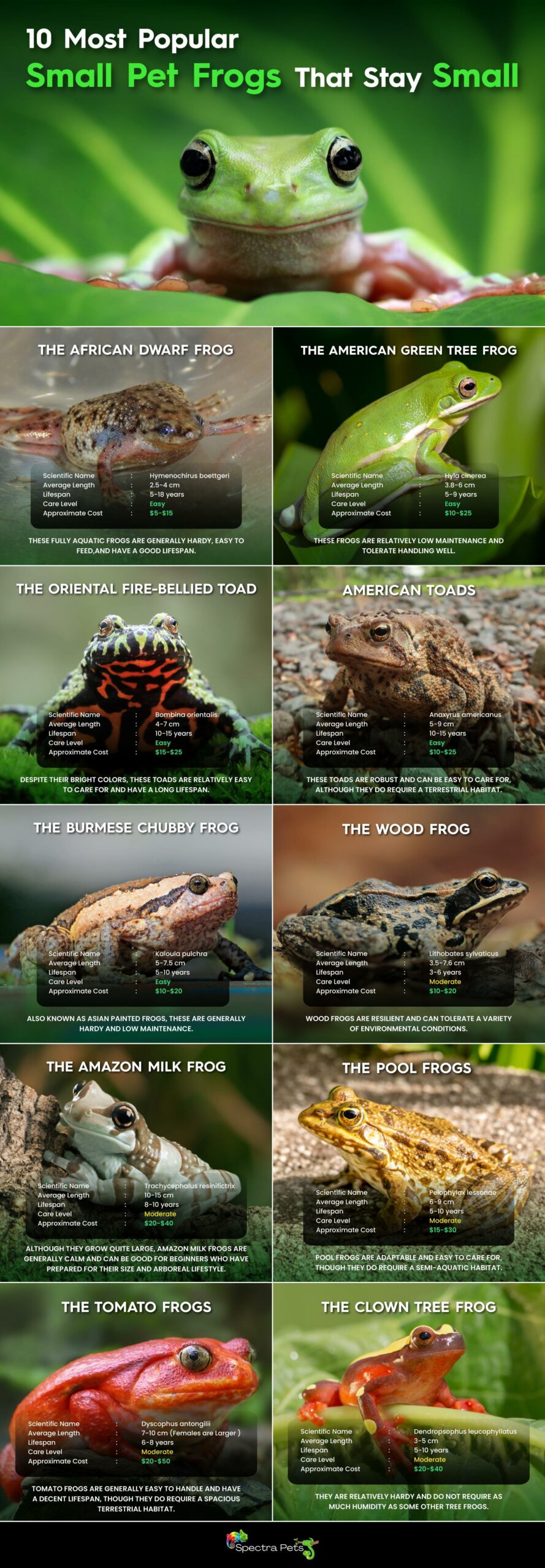
If you want to get a printable version of this infographic click here! If you want to use this infographic on your website, please link back to this post as the source
What Is the Smallest Frog Species Suitable for Pet Ownership?
When it comes to the smallest frogs that you can own as pets, the Strawberry Poison-Dart Frog (Oophaga pumilio) often tops the list. Known for its striking colors and tiny size, adults of this species typically only reach a length of 0.75 to 1.5 inches (1.9 to 3.8 cm). These vibrant frogs are native to Central America and are popular in the pet trade, requiring a well-maintained environment and diet of small invertebrates.
However, when considering the smallest frogs in the world, the Brazilian Gold Frog, or Izecksohn’s Toad (Brachycephalus didactylus), stands out. This frog, one of the smallest terrestrial vertebrates, measures a minuscule 9.6-9.8 mm in length in adulthood. Its vibrant golden color has earned it its common name.
Although the Brazilian Gold Frog is significantly smaller than the Strawberry Poison-Dart Frog, it’s not typically recommended as a pet due to its specific habitat needs and delicate nature. These frogs are more suited to controlled environments for research and professional study, rather than a typical home setting. As such, potential pet owners are advised to consider other, more manageable species, like the Strawberry Poison-Dart Frog.
Why Opt For Smaller Frogs?
Small frogs make delightful pets for a number of reasons. Let’s hop into the world of these miniature amphibians and discover why they could be the perfect addition to your home.
Size-Specific Advantages
Small frogs are space savers. They can comfortably live in smaller tanks or terrariums, making them perfect for pet lovers with limited space. This can also reduce the cost and effort involved in setting up and maintaining their habitat. Plus, their small size allows for detailed observation, so you can enjoy their daily habits up close.
Variety and Vibrancy
Small frogs offer a huge variety of colors, patterns, and species to choose from, making them visually appealing pets. From the vibrant Golden Poison Dart Frog to the adorable tiny Brazilian Gold Frog, there’s a mini frog species to suit every aesthetic preference.
Relatively Easy Care
Many small frog species are quite hardy and can adjust to different conditions, making them relatively easy to care for. They also have simpler dietary needs compared to larger pets. This ease of care is ideal for beginner pet owners or those with a busy lifestyle.
Educational Value
These tiny jumpers are also a great way to learn about the wonders of nature. Owning and caring for a small frog can provide valuable lessons in biology, responsibility, and conservation.
Quiet and Non-disruptive
Frogs are quiet pets that can be active at different times of the day, depending on their species. They’re a fantastic choice if you’re looking for a pet that won’t disrupt your daily activities or sleep with loud noises.
Fascinating Behaviors
Despite their small size, frogs have fascinating behaviors that are interesting to observe. Their feeding rituals, climbing antics, or peculiar mating calls can provide endless entertainment.
So, if you’re considering a pet that’s compact, colorful, relatively low-maintenance, educational, and intriguing, small frogs could be just the ticket. Remember, each frog species has its unique needs and behaviors, so it’s important to do thorough research before making your decision.
24 Top Pet Frogs That Don’t Grow Large
One thing about having pets is they become increasingly harder to take care of the bigger they are. This goes for every kind of pet, such as cats, dogs, snakes, etc. It is also true for frogs, as bigger frogs need bigger tanks and more food. That’s why some people, especially people who are new to having frogs as pets, prefer frog species that are small in general. This means these frogs don’t grow past 4-4.5 inches even if they are full-grown. The top choices for such frogs are:
1. The African Dwarf Frog
- Scientific Name: Hymenochirus boettgeri
- Average Length: 2.5-4 cm
- Lifespan: 5-18 years
- Care Level: Easy
- Approximate Cost: $5-$15
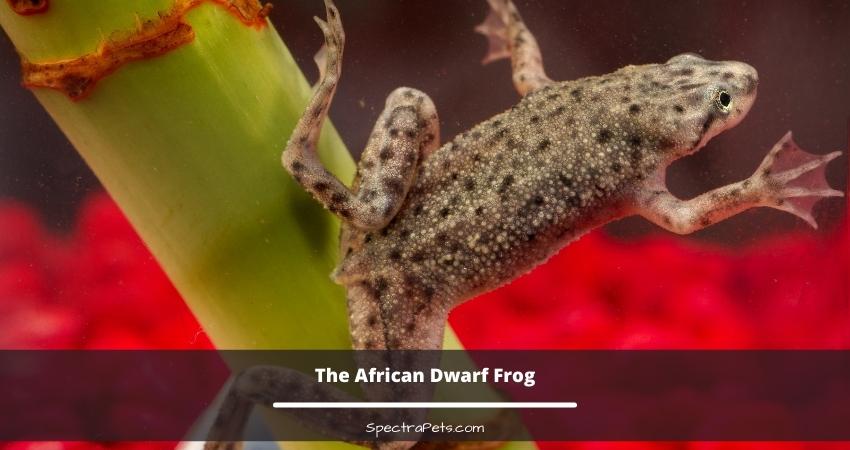
Coming from Southern Africa, the African Dwarf frogs love water. These frogs don’t leave water unless they have to. The frogs are very easy to maintain as they don’t need much of anything. They can also be kept with fish, so it means they are pretty tolerant of other species in their tank.
Due to their small size, which barely goes past the 3-inch mark, the African Dwarf frogs don’t need a big tank. Only a 5-gallon tank will suffice; all you need to do is to make sure the water parameters are perfect. There needs to be adequate water in the tank for the frog to dive and stay underneath. These frogs don’t come up to the surface, only when they need to breathe.
Also, the African Dwarf Frogs are not only tolerant of other species in their tank, but they are also tolerant of other African Dwarf frogs as well. So if you want to keep more than one of them in a single tank, you can do that. One African Dwarf Frog costs in the region of 4 dollars only, which is quite cheap.
2. The Gray Tree Frog
- Scientific Name: Hyla versicolor
- Average Length: 3.8-5 cm
- Lifespan: 7-9 years
- Care Level: Moderate
- Approximate Cost: $15-$30

Moving on from Africa to North America for now, the Gray Tree frog can be found in the USA. These tiny frogs don’t even reach 3 inches in length when adults, making them perfect for beginners. These frogs are a bit endangered, so it’s a must that you buy them from breeders to make sure the species is protected.
The tank size should be around 10 to 20 gallons, but the trick is to have a tank that has a lot of height as well as things to climb inside. The reason behind this is the Gray Tree Frog, as its name implies, is arboreal. So they need to have trees or twigs inside the tank for them to climb. Since they don’t come from a climate that has a lot of humidity, the tank shouldn’t have that much humidity as well.
Additional Read: Are gray tree frogs poisonous?
Taking care of the Gray Tree frogs is pretty easy as well. Apart from not needing to maintain high humidity in the tank, their diet isn’t very complicated either. These little guys eat insects, so feeding them insects that are smaller than them should be just enough. But they should be handled with care if they are handled at all. Because these frogs secrete toxins that can be very powerful and damaging.
3. The Darwin’s Frog
- Scientific Name: Rhinoderma darwinii
- Average Length: 2.2-3.25 cm
- Lifespan: 10-15 years
- Care Level: Difficult (Conservation status: Threatened)
- Approximate Cost: Not available for trade due to conservation status

Named after the father of the theory of evolution, whenever the topic of small frogs is discussed, Darwin’s frog’s name comes up. These frogs are exquisitely beautiful as well as extremely small. Even when they are adults, these frogs grow as big as 1.2 inches only.
The reason Darwin’s Frogs are so popular isn’t their size or vivid coloration. These frogs are excellent parents and will go to any length to protect their young. That’s why it’s a shame that these frogs are very rare and can hardly be bought from shops.
4. The Burmese Chubby Frog
- Scientific Name: Kaloula pulchra
- Average Length: 5-7.5 cm
- Lifespan: 5-10 years
- Care Level: Easy
- Approximate Cost: $10-$20
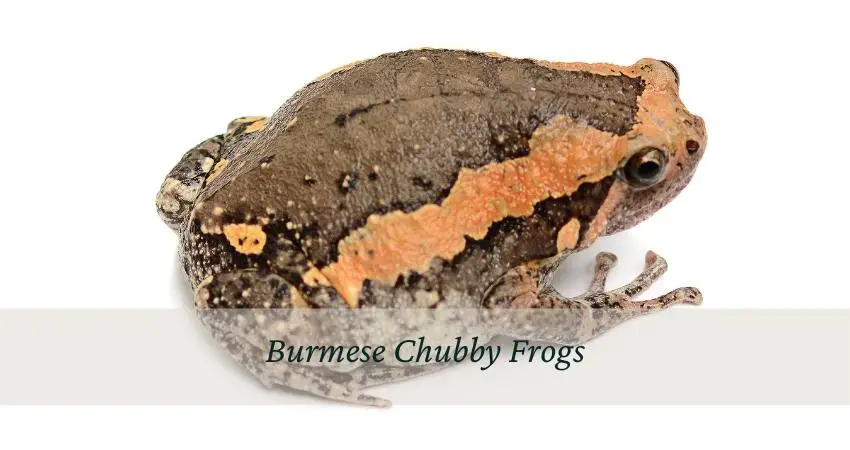
Found in Southeast Asia, the Burmese Chubby frog is known for their round appearance. Despite being chubby, these frogs are quite small, reaching only 3 inches in size. They can be kept in a group of 2 or 3 in a tank of 15 gallons size. Since the area they come from is quite humid, the tank humidity should be kept around 70%.
The Burmese Chubby Frogs are insectivorous, so their diet consists of mostly insects. This attribute makes them quite easy to take care of. These frogs also don’t require much space at all. But one thing you must avoid is handling them, as their skins are not suitable for this.
5. The Madagascar Golden Frog
- Scientific Name: Mantella aurantiaca
- Average Length: 2-3 cm
- Lifespan: 8-10 years
- Care Level: Difficult (Conservation status: Threatened)
- Approximate Cost: Not available for trade due to conservation status

Also known as the Golden Mantella, the Madagascar Golden Frogs are a popular choice among people who want a small frog as their pet. This frog is so small that it barely reaches an inch in length when fully grown. A vividly colored frog, these beautiful creatures are often mistaken for dart frogs due to their color patterns.
The Madagascar Golden Frogs are so small that a tank of only 5-gallon volume will suffice. But it has to be kept in mind that these frogs must not be handled. As with most colorful frogs, they secrete toxins that are harmful to the human body. Although these toxins are not fatal, they are still able to make you quite sick.
6. The American Green Tree Frog
- Scientific Name: Hyla cinerea
- Average Length: 3.8-6 cm
- Lifespan: 5-9 years
- Care Level: Easy
- Approximate Cost: $10-$25
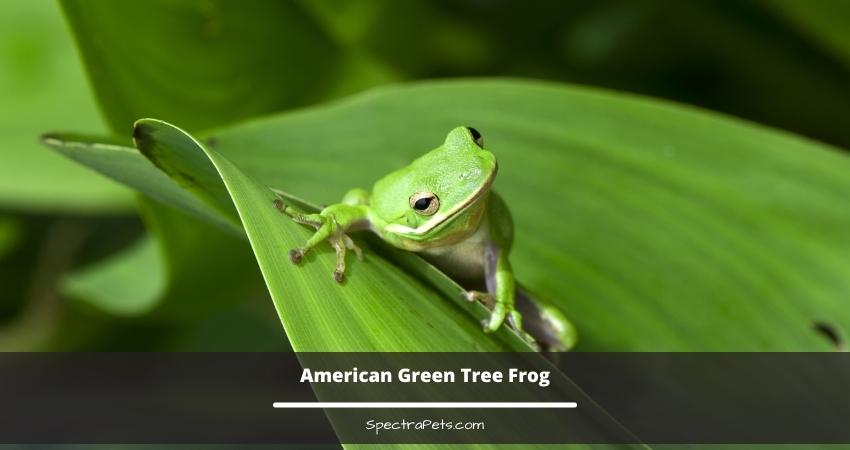
Yet another frog that is found in the Americas, the American Green Tree Frog can be found in states in the central USA as well as the southeast states. Since these are arboreal, these frogs don’t need a tank with too much volume, but the tank must have a bit more height than usual.
One huge advantage of having an American Green Tree frog is they are very timid and they don’t secrete toxins. So you can handle them a bit. You can even keep a couple of them in a tank without any hitch. These frogs are also very low maintenance, as no artificial heating is necessary for them.
7. The Brazilian Gold Frog
- Scientific Name: Brachycephalus didactylus
- Average Length: 1 cm
- Lifespan: 10-15 years
- Care Level: Difficult (Endangered)
- Approximate Cost: Not available for trade due to conservation status
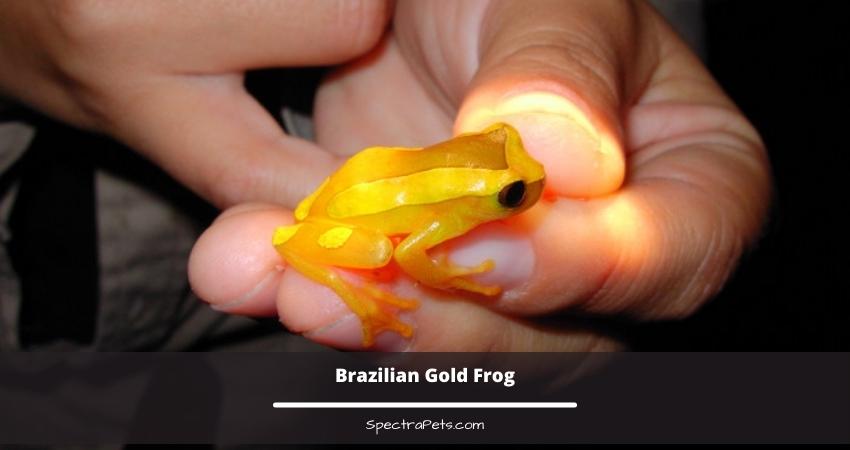
Native to South America, the Brazilian Gold Frog is another small frog that is popular among pet owners around the world. Beginners especially love this frog which doesn’t even reach half an inch in length when fully grown. Due to their incredibly small size, they don’t need any large or even medium-sized tanks.
Due to being from the forests of South America, they need humid conditions to thrive. But the temperature in the tank shouldn’t be very high as they need cooler conditions to survive. You can keep multiple Brazilian Gold Frogs in a single tank.
8. The Monte Iberia Eleuth
- Scientific Name: Eleutherodactylus iberia
- Average Length: 1 cm
- Lifespan: 1-2 years
- Care Level: Unknown (Endangered)
- Approximate Cost: Not available for trade due to conservation status
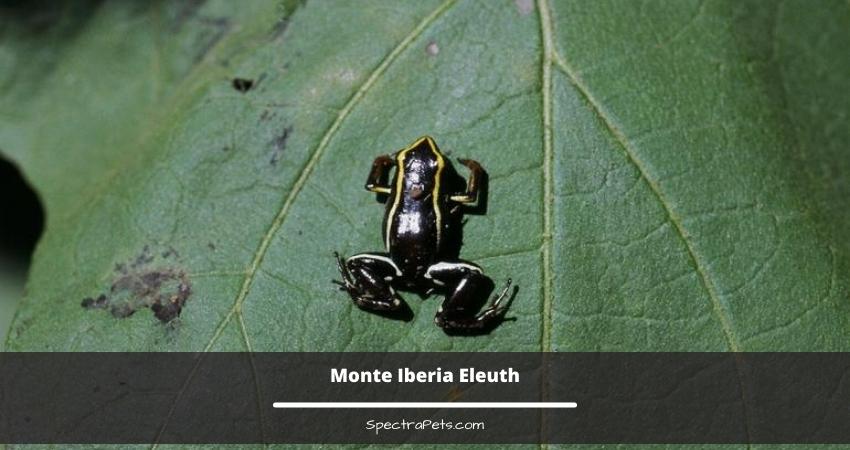
Another frog that can rival the Brazilian Gold Frog in terms of how small they are, the Monte Iberia Eleuth is a frog that is quite popular, but they are rare and endangered as well. These frogs rank lower than their Brazilian counterparts for a couple of reasons.
First, the Monte Iberia Eleuth is very lightweight. They don’t even weigh a tenth of an ounce when they are adults. This makes them incredibly fragile. Also, these frogs require quite high maintenance, since the temperature of the tank has to be maintained to perfection. Otherwise, these frogs get seriously affected if the conditions change even the slightest. These frogs aren’t also suitable for handling.
9. The Amazon Milk Frog
- Scientific Name: Trachycephalus resinifictrix
- Average Length: 10-15 cm
- Lifespan: 8-10 years
- Care Level: Moderate
- Approximate Cost: $20-$40

Unlike the frog mentioned before, Amazon Milk Frogs don’t need much maintenance. This frog wasn’t on the list of pet owners until very recently. These frogs have a unique color which makes them quite different from other frogs. An adult female Amazon Milk frog can reach 4 inches in length, whereas a male can only reach half that length.
These frogs need humid conditions to survive. The humidity in a tank with Amazon Milk Frogs has to have at least 70 to 80 percent. These frogs also need to have UVB lighting in their tanks to survive. Keeping the frogs in the vicinity of your bedroom is a bad idea, as these frogs can be quite noisy. They also don’t want to be handled.
10. American Toads
- Scientific Name: Anaxyrus americanus
- Average Length: 5-9 cm
- Lifespan: 10-15 years
- Care Level: Easy
- Approximate Cost: $10-$25
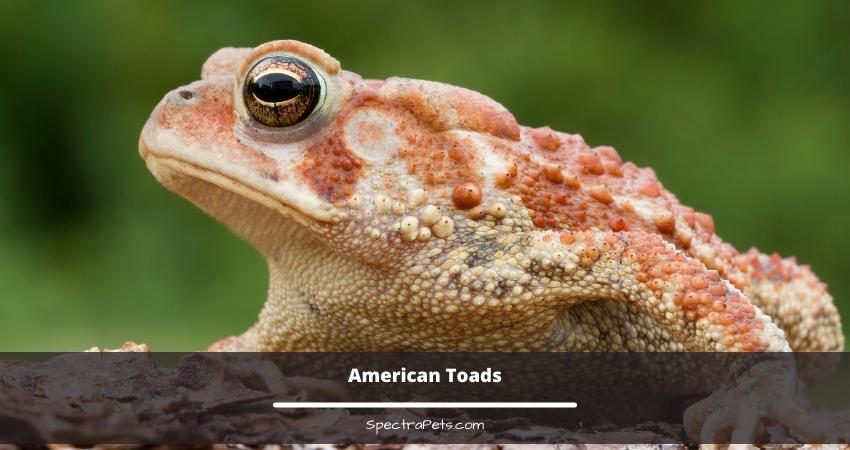
A well-known species in North America, the American Toads are an aquatic species. Search near any pond or wet forest, you can find one yourself. These are also among the small amphibians people look for to keep as a pet. A full-grown American Toad is only three inches long.
The American Toads can change their skin color when threatened or under stress. These toads have a long lifespan and can adapt to conditions very quickly. But one thing that mustn’t be done is handling them. They secrete toxins that can harm you, also the oil from your hands can fatally damage the skins of the toads
11. The Oriental Fire Bellied Toad
- Scientific Name: Bombina orientalis
- Average Length: 4-7 cm
- Lifespan: 10-15 years
- Care Level: Easy
- Approximate Cost: $15-$25
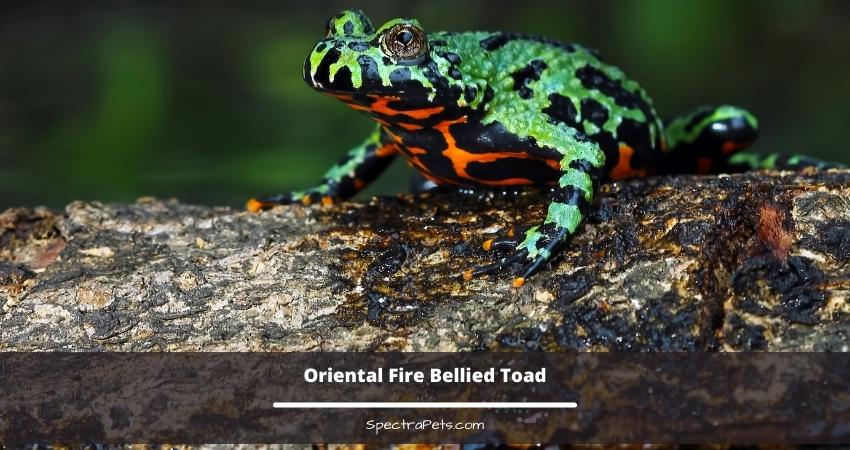
Yet another toad, but this time a more vividly colored one, the Oriental Fire Bellied Toad is very popular among pet owners. The stomach of this toad is, as the name suggests, red like raging fire. The body of the toad is green with dark spots throughout their bodies.
The Oriental Fire Bellied Toad is found in eastern Asia, but nowadays breeders are the most common source of these amphibians. These toads aren’t very high maintenance, but they can be very defensive about their territories. Like most animals in this list, you mustn’t handle them as they are venomous.
12. The Desert Rain Frog
- Scientific Name: Breviceps macrops
- Average Length: 4-6 cm
- Lifespan: Unknown
- Care Level: Unknown
- Approximate Cost: Not usually available for trade
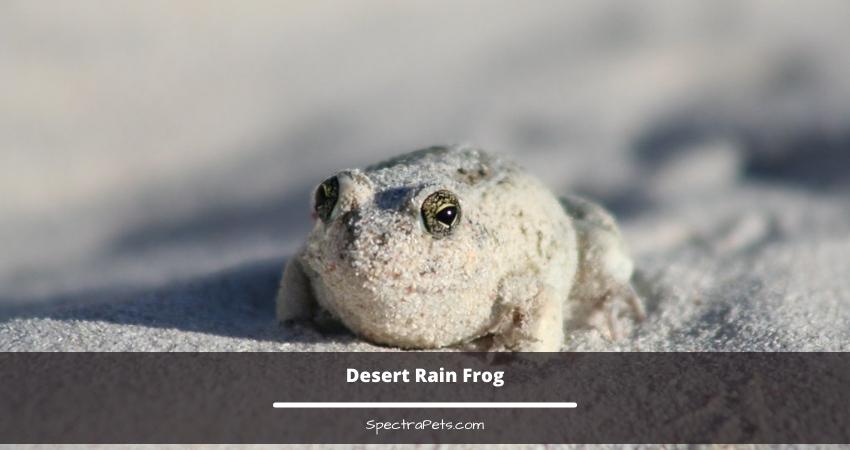
Also called the Short-headed frog by many, The Desert Rain frog is another frog that doesn’t grow too much. It only grows up to around 2 and a half inches and looks like a potato. These frogs don’t need a big tank, nor is their maintenance high.
While that is all well and good, the Desert Rain Frog has some requirements when it comes to humidity and overall conditions of the tank. The tank that these frogs are kept in must have around 75 to 100% humidity, which is a lot. To aid you in maintaining this huge amount of humidity, you need to have substrates that absorb moisture.
13. The Wood Frog
- Scientific Name: Lithobates sylvaticus
- Average Length: 3.5-7.6 cm
- Lifespan: 3-6 years
- Care Level: Moderate
- Approximate Cost: $10-$20

Not only are the Wood frogs very small, but they are also very lightweight as well. Coming at three and a quarter inches long and only 0.28 ounces weight, they are very popular among new pet owners. These frogs can live in a group, and don’t roam around the tank. So you can easily keep multiple of these in a regular-sized tank.
The problem with the Wood Frogs isn’t with their behavior, rather it’s their lifespans. These frogs can’t handle cooler temperatures. They also don’t live for more than 5 years, which is a bummer as you can’t keep them as long as you want to.
14. The Glass Tree Frog
- Scientific Name: Hyalinobatrachium valerioi
- Average Length: 2.5-3 cm
- Lifespan: 5-14 years
- Care Level: Moderate
- Approximate Cost: $20-$50

One of the most unique frogs, or animals for that matter out there, the Glass Tree Frogs will be an exquisite collection for your pet collection. These frogs have abdominal skins that are completely translucent, giving them a very unique look.
Barely reaching 3 inches in length, adult Glass Tree Frogs weigh only 14 grams maximum. The tank size shouldn’t be that big, but it should be pretty high as these frogs live in trees. You must have some sort of plants or other platforms for them to climb on. Multiple Glass Tree Frogs can be kept in one 20-gallon-sized tank.
These frogs are pretty low maintenance too, as they are nocturnal. Being insectivorous, their diet needs a lot of insects, and that’s about it as far as their maintenance goes.
15. The Bumblebee Walking Toad
- Scientific Name: Melanophryniscus stelzneri
- Average Length: 2-2.5 cm
- Lifespan: 10-15 years
- Care Level: Difficult
- Approximate Cost: $20-$60
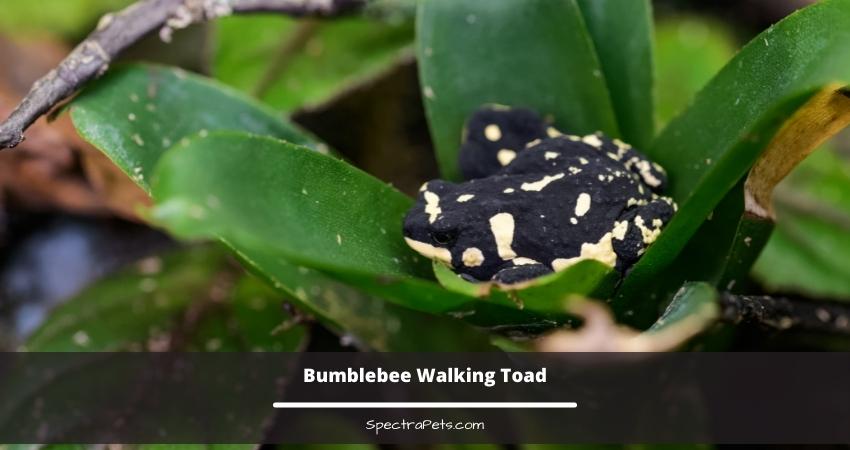
Often mistaken for Oriental Fire Bellied Toad, the Bumblebee Walking toad’s body is not green. Unlike their Asian cousins, these toads are from the South American countries of Argentina and Paraguay. Instead of green, these toads’ bodies are colored yellow with black spots, hence the name bumblebee.
These toads never grow past 1.5 inches in length and can be kept in numbers of more than one. A 20-gallon tank can house up to 4 of them. If proper care is taken, the Bumblebee Walking Toads can live for over 10 years.
16. The Pool Frogs
- Scientific Name: Pelophylax lessonae
- Average Length: 6-9 cm
- Lifespan: 5-10 years
- Care Level: Moderate
- Approximate Cost: $15-$30
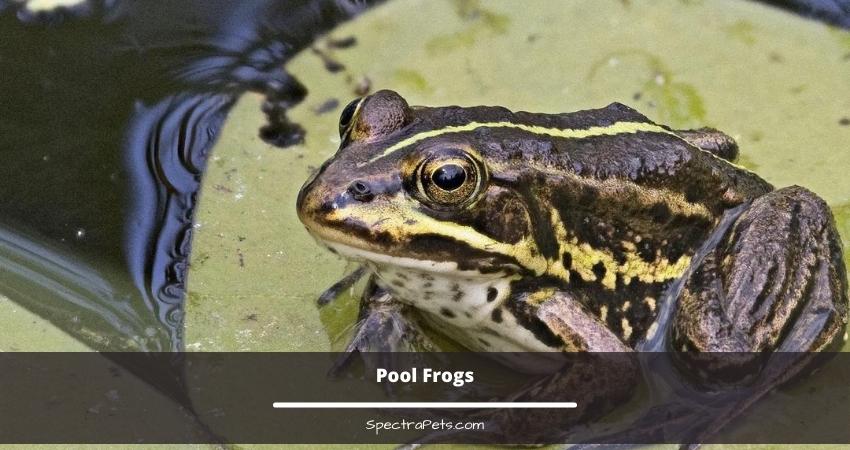
A rare kind of frog, the Pool Frogs are very popular among pet lovers, especially those who want a frog as their pet. Taking care of these 3-inch-long frogs is very easy as they aren’t exactly picky with what they eat. The tank size is also quite reasonable.
But the Pool Frogs release toxins when they feel threatened. So, it’s not a very good idea to handle them, despite them looking very cute.
17. The Bumblebee Dart Frog
- Scientific Name: Dendrobates leucomelas
- Average Length: 3-5 cm
- Lifespan: 10-15 years
- Care Level: Moderate
- Approximate Cost: $30-$60
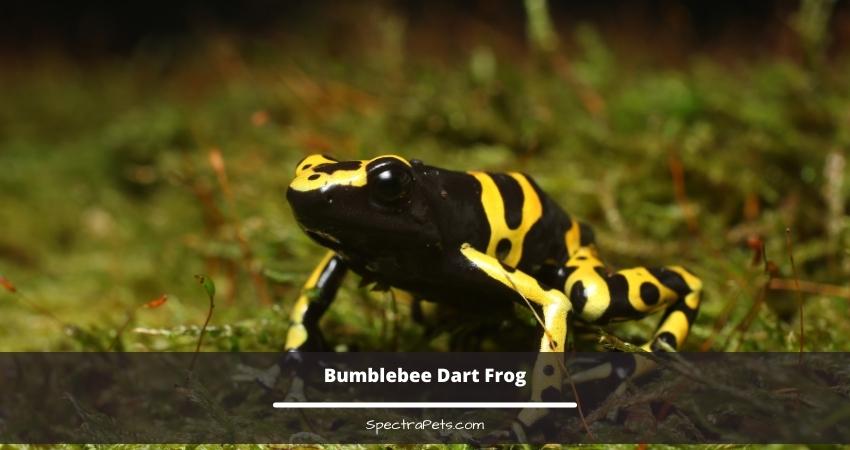
Yet another amphibian that is named Bumblebee, the Bumblebee Dart Frog is a thing of beauty. Its black and yellow body not only makes it eye-catching but also makes it extremely popular among pet lovers.
These beautiful creatures are very small, even when they are fully grown. An adult Bumblebee Dart Frog only reaches 1.97 inches in length.
Keeping these frogs in a tank is not a very difficult task. Multiple of these small frogs can be kept in a 10-gallon tank.
As they are very active, you can enjoy them moving about in the tank. They live for a decade or two if proper care is taken.
18. The Waxy Monkey Frog
- Scientific Name: Phyllomedusa sauvagii
- Average Length: 7-9 cm
- Lifespan: 10-15 years
- Care Level: Moderate
- Approximate Cost: $30-$60
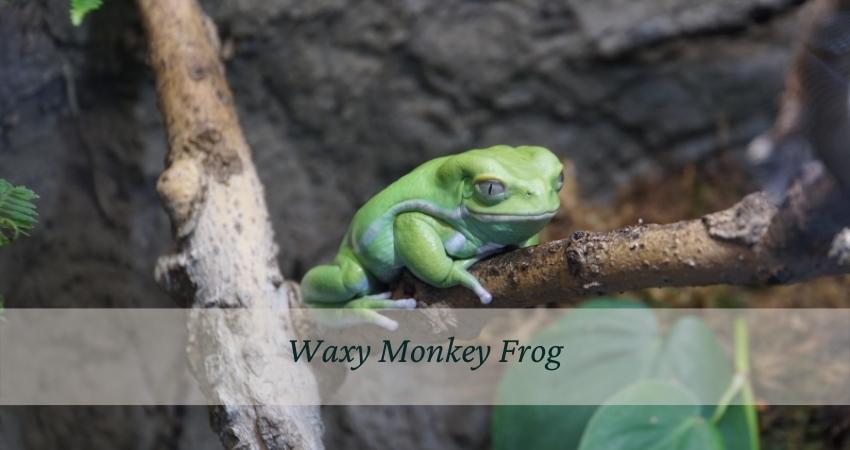
A unique one even in a list full of unique frogs, the Waxy Monkey Frog doesn’t hop like its cousins. Rather this beautiful frog walks around the tank. They are bright green and have a waxy texture on their skin. That’s why sometimes they are called leaf frogs.
A native of South America, the Waxy Mountain Frogs are quite good climbers, so you need to have higher tanks so that they can’t get out. Also, having something to climb inside the tank will come in quite handy. These frogs reach the length of only 3 inches as an adult, so a regular-sized tank is more than adequate for them.
The Waxy mountain frogs don’t like to be handled. Other than that they can be very easily maintained. Also, they are quite active. So they are a great addition to your house if you can refrain from handling them.
19. The Green and Black Dart Frogs
- Scientific Name: Dendrobates auratus
- Average Length: 4-6 cm
- Lifespan: 10-15 years
- Care Level: Moderate
- Approximate Cost: $20-$50

Yet another dart frog and a beautiful one at that, the Green and Black Dart Frogs always come near the top of the list of pet frogs that stay small. These frogs stay very small indeed, even when fully grown, reaching only one and a half inches in length. These frogs are not very complicated to the house.
A 10-gallon tank is more than enough for a couple of Green and Black Dart Frogs. Also, these frogs don’t need any special treatment when it comes to temperature or lighting in the tank, making them incredibly low maintenance.
Read More: How big do dart frogs get?
20. The Clown Tree Frog
- Scientific Name: Dendropsophus leucophyllatus
- Average Length: 3-5 cm
- Lifespan: 5-10 years
- Care Level: Moderate
- Approximate Cost: $20-$40
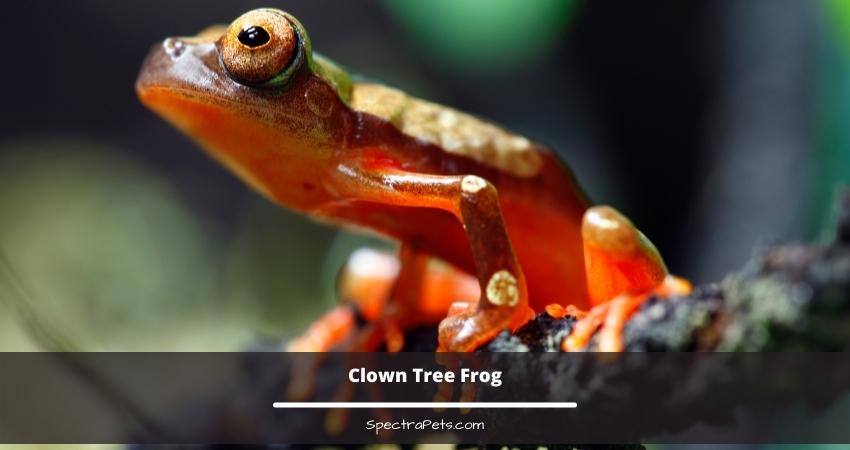
As far as names go, barely any animal has been named more aptly than the Clown Tree Frogs. The skin of these frogs looks a lot like the dress of a clown. Growing up to only a couple of inches, these frogs are perfect for anyone who is looking for a frog that doesn’t grow too large.
Keeping the Clown Tree Frogs in a tank is very easy. As they can live in groups, keeping multiple of them in a tank that is 10-15 gallons in size shouldn’t pose too many difficulties. But avoid handling them as their skins are very sensitive.
21. The Red Eyed Tree Frogs
- Scientific Name: Agalychnis callidryas
- Average Length: 5-7 cm
- Lifespan: 5-10 years
- Care Level: Moderate
- Approximate Cost: $30-$60

Found in Central America and Australia, the Red Eyed Tree Frogs are excellent pets. These frogs have bright red eyes and green bodies that are equally bright. They only reach about three inches when they are full grown. So keeping them in regular-sized tanks will not be an issue.
But as with all other tree frogs, the height of the tank is a thing of concern. The tank should be pretty high as the Red Eyed Tree Frogs love to climb. Also, make sure that the conditions of the tank are moist as well as humid, otherwise, these frogs will not survive. These frogs also don’t tolerate too much handling, so keep that in mind.
22. The Strawberry Dart Frogs
- Scientific Name: Oophaga pumilio
- Average Length: 2-3 cm
- Lifespan: 8-12 years
- Care Level: Difficult
- Approximate Cost: $30-$60

When it comes to having eye-catching colors and patterns, dart frogs have beat every other kind of frog. The Strawberry Dart frogs are no exception to that. They have strawberry-colored skins and blue legs that give them a unique and vivid look. They are tailor-made for people who want small frogs as pets, having a maximum length of only 2 and a half inches.
These frogs are a little high maintenance when compared to most other small frogs, but it’s not too much. The room temperature during the day must not exceed 80 degrees Fahrenheit. Also, a photoperiod cycle of 12 hours should be maintained at all times. These frogs eat insects, so feeding them insects that are smaller than them will suffice as long as their diet is concerned.
23. The Golden Poison Dart Frog
- Scientific Name: Phyllobates terribilis
- Average Length: 4-6 cm
- Lifespan: 10-15 years
- Care Level: Difficult
- Approximate Cost: $50-$100
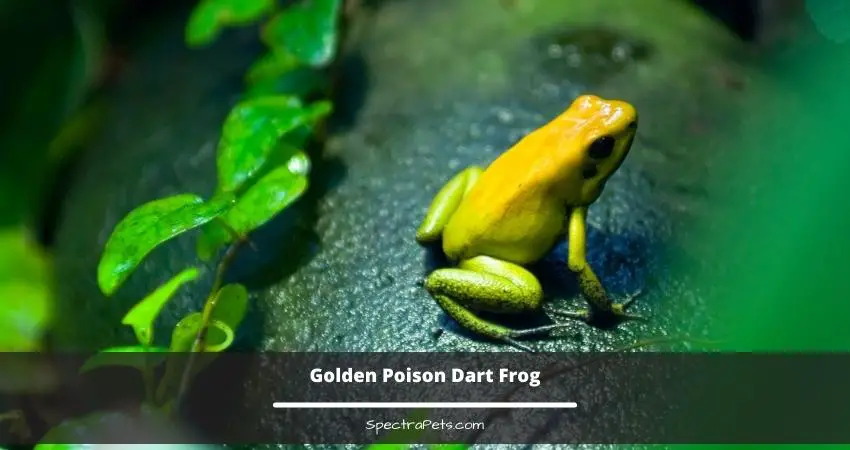
Yet another dart frog, the Golden Poison Dart Frogs are very popular, even among dart frogs. A lot of its popularity can be attributed to its beautiful golden coloring as well as its small size. An adult Golden Poison Dart Frog reaches only 2 inches in length.
The tank size of these frogs needs to be a bit larger since they are very active and love to hop about inside the tank. For two Golden Poison Dart Frogs, the ideal tank size should be around 20 gallons. Also, these frogs aren’t meant to be handled. They don’t have Poison in their names for anything.
24. The Tomato Frogs
- Scientific Name: Dyscophus antongilii
- Average Length: 7-10 cm (females are generally larger than males)
- Lifespan: 6-8 years
- Care Level: Moderate
- Approximate Cost: $20-$50
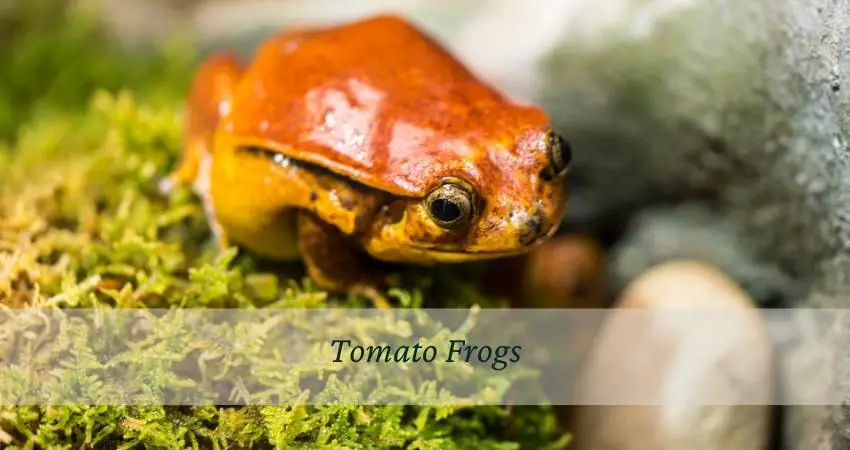
Last, but not least, the Tomato Frogs look exactly like what their name implies, a Tomato. Native to the northern part of Madagascar, these frogs are very adaptable to whatever conditions they are in. These frogs grow up to only 3 inches long, so they are ideal for small frog lovers.
The Tomato Frogs are not high maintenance, so keeping them in a tank doesn’t pose many problems. They don’t require any specific lighting, nor do they need varieties in their diet. Just feeding them insects will do just fine. You can even keep a couple of them in a regular-sized tank.
What Is The Easiest Frog To Take Care Of?
The American Green Tree Frog (Hyla cinerea) is often considered one of the easiest frogs to take care of, making it an excellent choice for beginners. This frog species is native to the southeastern United States, and its diet mainly consists of insects like crickets and small worms.
Green Tree Frogs are generally quite hardy and adapt well to captive environments. They are relatively small in size, growing to about 2 to 2.5 inches (5.1 to 6.4 cm) in length, and typically display a bright green color, although this can change depending on their mood and environment.
Their care requirements include a well-ventilated terrarium with plenty of climbing space, as they are an arboreal species. The habitat should be kept humid and include a shallow water dish for the frog. Importantly, they are nocturnal, which means they are most active during the night.
However, it’s crucial to note that while Green Tree Frogs are relatively easy to care for, they still require a commitment to provide a proper diet and maintain a clean and suitable environment. All potential frog owners should thoroughly research their pet’s needs to ensure they can provide appropriate care.
Things To Consider Before Buying Small Frogs
Before you decide to buy a small frog as a pet, there are a few things you should take into consideration.
- Firstly, take a look at the list and understand which frog best suits your needs. Review all the size and life span and see if it matches your lifestyle and desires.
- Secondly, consider what size tank your frog will need to be healthy and happy. When you’re considering what size tank your frog will need, it’s essential to think about both the short- and long-term. A small tank might be fine for a small frog, and since they grow 1–2 inches in their life, that tank is enough. You can even design a terrarium for them.
- Lastly, consider how much time you’ll have for the upkeep of your new small pet frog! If you plan on spending a lot of time with your new pet, then that might not be an issue.
Final words
Getting a pet is easy, but taking proper care of them so that they live a long life is hard. Once you adopt any one of the most popular pet frogs that stay small, make sure they’re well taken care of, including the conditions and the diet. Also, most small frogs are toxic, so not handling them is the best way to keep them and yourself healthy.

